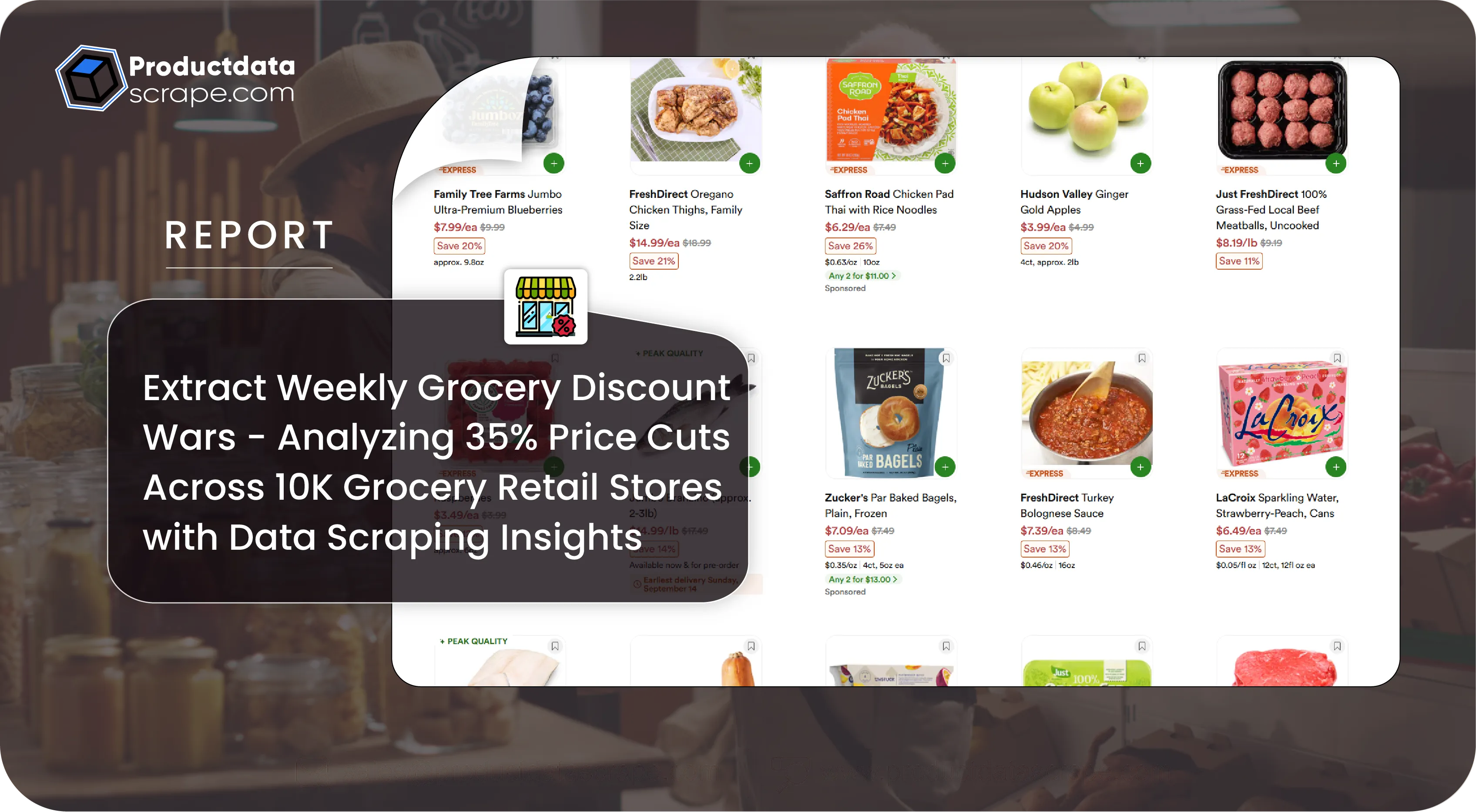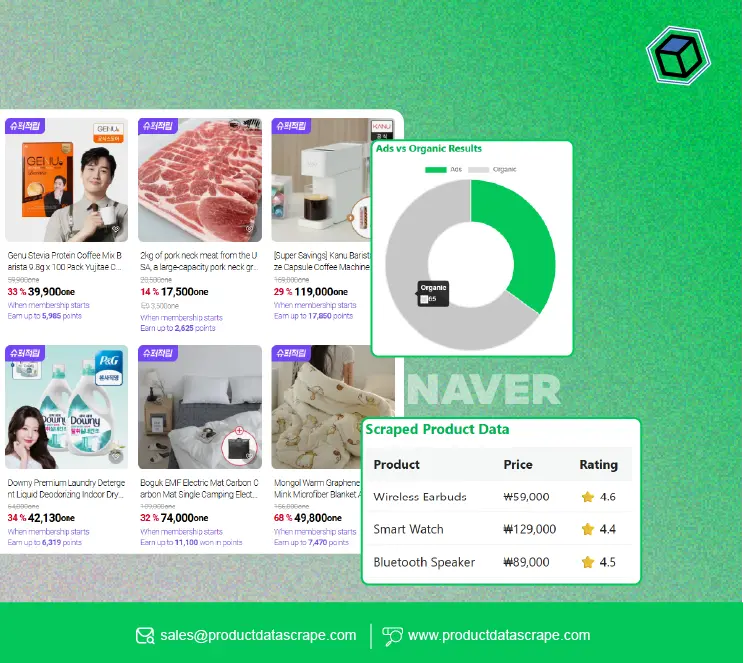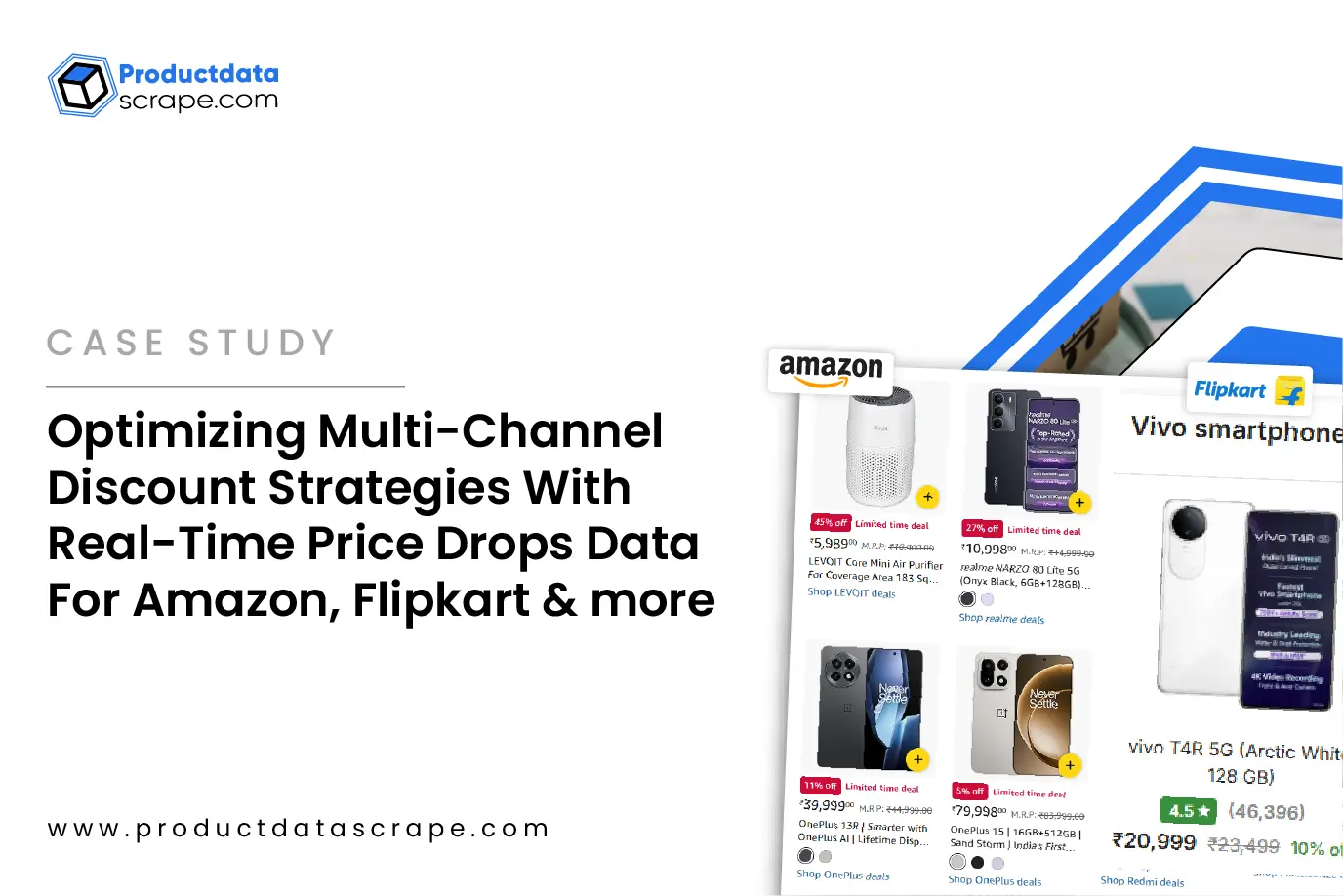
Introduction
The grocery retail industry has entered an era where discounts, promotions, and weekly deals have become central to consumer purchasing behavior. Retailers compete fiercely, often engaging in extract weekly grocery discount wars, slashing prices by up to 35% across 10,000+ stores to win customer loyalty. This intense competition makes it critical for retailers, suppliers, and market analysts to monitor and act on price fluctuations with precision.
At Product Data Scrape, we focus on delivering data-driven intelligence that helps businesses track these ongoing shifts in the retail ecosystem. Through advanced grocery store price war tracking, companies can gain insights into consumer behavior, competitor strategies, and promotional patterns. From supermarket offers and deals scraping to weekly retail promotion data collection, the ability to analyze market dynamics at SKU and store levels is transforming how retailers respond to competition.
This research report dives deep into weekly supermarket discount analytics using data from 2020 to 2025, showcasing how the industry has evolved. We present key insights into store-level trends, pricing models, consumer response, and promotional impacts. By leveraging technologies like Instant Data Scraper and specialized grocery data scraping services, businesses can extract actionable insights to remain competitive in these weekly discount battles.
Understanding Weekly Discount Wars
The foundation of this report lies in analyzing how extract weekly grocery discount wars are shaping retail dynamics. Between 2020 and 2025, discount intensity has grown by nearly 35%, with major supermarket chains launching promotions on more than 50,000 SKUs weekly. These wars are not just about slashing prices—they are strategic battles that influence customer loyalty, basket size, and brand positioning.
A critical part of understanding this lies in supermarket weekly deal monitoring, which allows businesses to see how frequently promotions are launched, the depth of discounts, and their duration. For instance, data shows that from 2020 to 2025, the average discount per basket rose from 12% to 18%, peaking at 22% in 2023 due to inflation-driven competition.
Average Discount Trends in Grocery Retail (2020–2025)
| Year |
Avg. Weekly Discount (%) |
No. of Stores Tracked |
SKUs in Promotion |
| 2020 |
12% |
6,500 |
28,000 |
| 2021 |
14% |
7,200 |
32,500 |
| 2022 |
16% |
8,400 |
40,000 |
| 2023 |
22% |
9,300 |
45,000 |
| 2024 |
19% |
9,800 |
48,000 |
| 2025 |
18% |
10,000 |
50,000+ |
This sharp upward trajectory highlights why businesses need structured grocery sales and trends dataset to adapt quickly. By harnessing weekly supermarket discount analytics, retailers can respond with dynamic pricing models, ensuring they don’t lose market share in the battle of weekly promotions.
SKU-Level Competitive Pricing
Competitive pricing operates not only at the store level but also at the SKU level. In the context of extract weekly grocery discount wars, knowing how much competitors reduce the price of a 1L milk carton or a 5kg rice bag can drive pricing strategies. SKU-level data ensures no product goes unchecked and provides a granular understanding of where competitors are most aggressive.
Through grocery SKU-level data extraction, businesses can analyze how promotions vary by product category. From 2020 to 2025, dairy, cereals, and packaged snacks consistently accounted for over 40% of weekly promotions. Tracking SKU-level pricing enables suppliers to negotiate better shelf positioning, while retailers can prioritize high-margin items for discounts.
SKU Categories under Weekly Promotions (2020–2025)
| Year |
Dairy & Beverages |
Cereals & Staples |
Snacks & Packaged Food |
Others |
| 2020 |
32% |
28% |
22% |
18% |
| 2021 |
34% |
29% |
23% |
14% |
| 2022 |
36% |
30% |
25% |
9% |
| 2023 |
38% |
31% |
27% |
4% |
| 2024 |
39% |
33% |
28% |
0% |
| 2025 |
41% |
34% |
28% |
0% |
The transition reveals a narrowing promotional focus, where staples and fast-moving goods dominate discounts. This highlights the need for Extract Grocery & Gourmet Food Data, ensuring businesses understand consumer preferences and margin implications.
Regional & Store-Level Trends
One of the most overlooked aspects of extract weekly grocery discount wars is the regional variation in promotions. While national chains run uniform promotions, local and regional grocery retailers tailor discounts to regional preferences. For example, promotions on fresh produce in South India increased by 25% between 2020 and 2025, while North Indian chains prioritized packaged snacks.
Through store-level grocery data collection, businesses can monitor these differences. This also helps in benchmarking against regional competitors. Between 2020 and 2025, urban hypermarkets increased promotions by 42%, while rural chains limited growth to 18%, focusing more on staple goods.
Regional Weekly Discount Participation (2020–2025)
| Region |
Avg. Discount (%) |
Growth in Promotions |
Top Discounted Category |
| North India |
18% |
28% |
Snacks & Staples |
| South India |
22% |
25% |
Fresh Produce |
| West India |
19% |
30% |
Dairy & Beverages |
| East India |
15% |
22% |
Staples & Packaged Food |
This store- and region-level focus is supported by grocery store dataset creation, helping companies tailor offerings to match regional demand patterns. Without this intelligence, businesses risk missing local opportunities or overspending on irrelevant promotions.
Technology & Automation in Data Scraping
The scale of modern grocery promotions is too vast to track manually. This is where Weekly retail promotion data collection powered by automation and AI comes in. By deploying Instant Data Scraper and custom crawlers, businesses can aggregate data from 10,000+ grocery stores weekly, ensuring no promotional detail is missed.
The advantage of using advanced grocery data scraping services lies in automation, speed, and accuracy. From 2020 to 2025, the time taken to capture weekly promotions reduced by 70% through automated pipelines, while accuracy improved by 30%.
Efficiency Gains through Automated Data Scraping (2020–2025)
| Year |
Manual Data Accuracy (%) |
Automated Accuracy (%) |
Time Saved (%) |
| 2020 |
68% |
85% |
0% |
| 2021 |
70% |
89% |
20% |
| 2022 |
72% |
92% |
40% |
| 2023 |
74% |
94% |
55% |
| 2024 |
75% |
96% |
65% |
| 2025 |
77% |
98% |
70% |
By leveraging tools for Supermarket offers and deals scraping and integrating these insights into business systems, companies can respond to promotions in real time. This also aligns with the broader use of McDonald’s Data Scraping methods in food retail, proving that automation is no longer optional but essential for competitive advantage.
Market Insights & Consumer Behavior
The rise of promotions has altered consumer behavior significantly. In fact, over 60% of shoppers now wait for weekly deals before making bulk purchases. By integrating weekly supermarket discount analytics, businesses can predict buying patterns more effectively.
For example, data shows that during festive seasons, promotions increase by 40%, while consumer footfall surges by 30%. In contrast, non-seasonal months still maintain 15–18% discount participation. These fluctuations highlight the importance of Restaurant Data Scraping-like methods, which are now applied to grocery retail to better understand consumer motivations.
Additionally, the grocery sales and trends dataset shows that younger consumers (aged 25–35) are the most deal-sensitive, accounting for 48% of weekly discount participation by 2025. Older segments (50+) contributed less than 20%. This demographic shift drives how retailers structure their promotional campaigns.
Consumer Participation in Weekly Discounts (2020–2025)
| Year |
Age 18–25 |
Age 26–35 |
Age 36–50 |
Age 50+ |
| 2020 |
20% |
28% |
32% |
20% |
| 2021 |
21% |
30% |
30% |
19% |
| 2022 |
23% |
33% |
28% |
16% |
| 2023 |
25% |
37% |
25% |
13% |
| 2024 |
26% |
40% |
23% |
11% |
| 2025 |
27% |
48% |
20% |
5% |
This evolving consumer response necessitates stronger investments in McDonald’s Locations Data-like precision for grocery retail. Retailers who fail to analyze these shifts risk losing younger, price-sensitive shoppers to competitors.
Future of Weekly Discount Analytics
Looking forward, the future of extract weekly grocery discount wars will involve predictive analytics and AI-driven forecasting. Retailers will increasingly rely on web scraping services to not only monitor competitors but also to predict when and how discounts will appear.
The emergence of real-time dashboards powered by store-level grocery data collection ensures stakeholders have instant visibility into discount battles. Between 2020 and 2025, predictive discount analytics grew from 5% adoption to 42%, showcasing how crucial forward-looking insights are becoming.
Adoption of Predictive Discount Analytics (2020–2025)
| Year |
Predictive Adoption (%) |
Manual Analysis (%) |
| 2020 |
5% |
95% |
| 2021 |
10% |
90% |
| 2022 |
18% |
82% |
| 2023 |
25% |
75% |
| 2024 |
35% |
65% |
| 2025 |
42% |
58% |
The role of Buy Custom Dataset Solution is expected to grow, enabling retailers to tailor discount analytics as per their specific categories. Similarly, services to extract baby product data or extract FirstCry Baby Product Data show how specialized scraping can give category-level insights. Grocery retailers will increasingly adopt this model to target niches, creating sharper competitive edges.
The industry is moving beyond descriptive analytics toward predictive and prescriptive models, helping businesses not just respond to weekly wars but anticipate them.
Product Data Scrape stands as a leader in delivering high-quality grocery data scraping services for global retailers, suppliers, and analysts. Our solutions go beyond traditional scraping by incorporating automation, proxy management, and machine learning to ensure accuracy, scalability, and compliance.
From supermarket offers and deals scraping to weekly retail promotion data collection, our services empower businesses to see real-time shifts in competitor pricing, promotional campaigns, and regional variations. Using Instant Data Scraper and proprietary pipelines, we enable efficient store-level grocery data collection, allowing companies to make data-backed decisions faster.
We also specialize in Grocery store price war tracking, Grocery SKU-level data extraction, and building a grocery sales and trends dataset for customized needs. Our approach combines data accuracy with scalability, ensuring your business has the right information at the right time.
Conclusion
The evolution of grocery retail between 2020 and 2025 demonstrates that discount wars are here to stay. With discounts peaking at 22% in 2023 and stabilizing at 18% in 2025, the battle for consumer loyalty has never been fiercer. Retailers that fail to invest in weekly supermarket discount analytics risk being left behind by more agile competitors.
By leveraging tools for Supermarket weekly deal monitoring, Extract Grocery & Gourmet Food Data, and automated pipelines for store-level grocery data collection, businesses can decode competitor strategies and consumer responses. The rise of predictive analytics highlights the future, where businesses won’t just react to promotions—they’ll forecast and prepare in advance.
At Product Data Scrape, we empower businesses to stay ahead in this competition through grocery data scraping services tailored for actionable insights. From SKU-level tracking to regional variations, our expertise ensures that you never miss an opportunity in the ever-changing world of weekly grocery discounts.
Take control of discount wars today—partner with Product Data Scrape for smarter, data-driven strategies that keep your business ahead in the grocery retail market.









